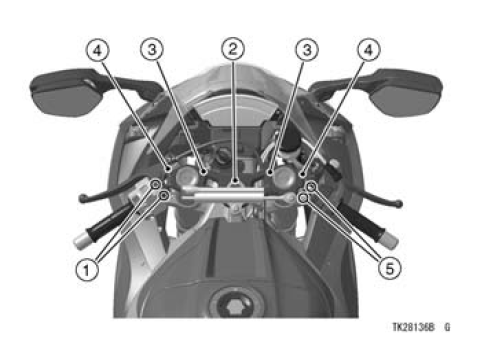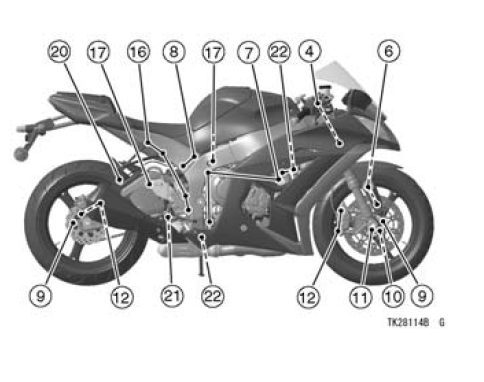

In accordance with the Periodic Maintenance Chart, it is very important to check the tightness of the bolts and nuts listed here. Also, check to see that each cotter pin is in place and in good condition. Please ask your authorized Kawasaki dealer for torque values.

1. Clutch Lever Holder Bolts
2. Steering Stem Head Nut
3. Handlebar Clamp Bolts
4. Front Fork Clamp Bolts
5. Brake Lever Mounting Bolts

6. Front Fender Mounting Bolts
7. Engine Mounting Bolts and Nuts
8. Rear Frame Mounting Bolts
9. Brake Disc Mounting Bolts
10. Front Axle Clamp Bolts
11. Front Axle Nut
12. Caliper Mounting Bolts
13. Side Stand Bolt
14. Suspension Likage Tie-Rod Nuts
15. Swingarm Pivot Shaft Nut
16. Footpeg Mounting Bolts
17. Rear Shock Absorber Mounting Bolts
18. Rear Axle Nut
19. Rear Sprocket Nuts

20. Silencer Mounting Bolt
21. Brake Pedal Bolt
22. Exhaust Pipe Mounting Bolt and Nuts
 Leather, Vinyl, and Rubber
Leather, Vinyl, and Rubber Storage
StorageSubthrottle Sensor Resistance Inspection
Turn the ignition switch to OFF.
Disconnect the subthrottle sensor connector.
Connect a digital meter [A] to the subthrottle sensor connector
[B].
Measure the subthrottle sensor resistance.
Subthrottle Sensor Resistance
Connections: BL lead [D] ←→ BR/BK lead [C]
Standard: ...
Terminal Numbers of ECU Connectors
1. Subthrottle Valve Actuator: Y/BK
2. Subthrottle Valve Actuator: BK/O
3. Unused
4. Front Wheel Rotation Sensor Signal: G/Y
5. Unused
6. Starter Lockout Switch: R/G
7. Gear Position Switch: G/R
8. Crankshaft Sensor (–): BK
9. Power Supply to Sensors: BL
10. Unused
11. Intake Air Pre ...
General Lubrication
Lubricate the points shown below,
with either motor oil or regular grease,
in accordance with the Periodic Maintenance
Chart or whenever the vehicle
has been operated under wet or rainy
conditions.
Before lubricating each part, clean off
any rusty spots with rust remover and
wipe off any g ...